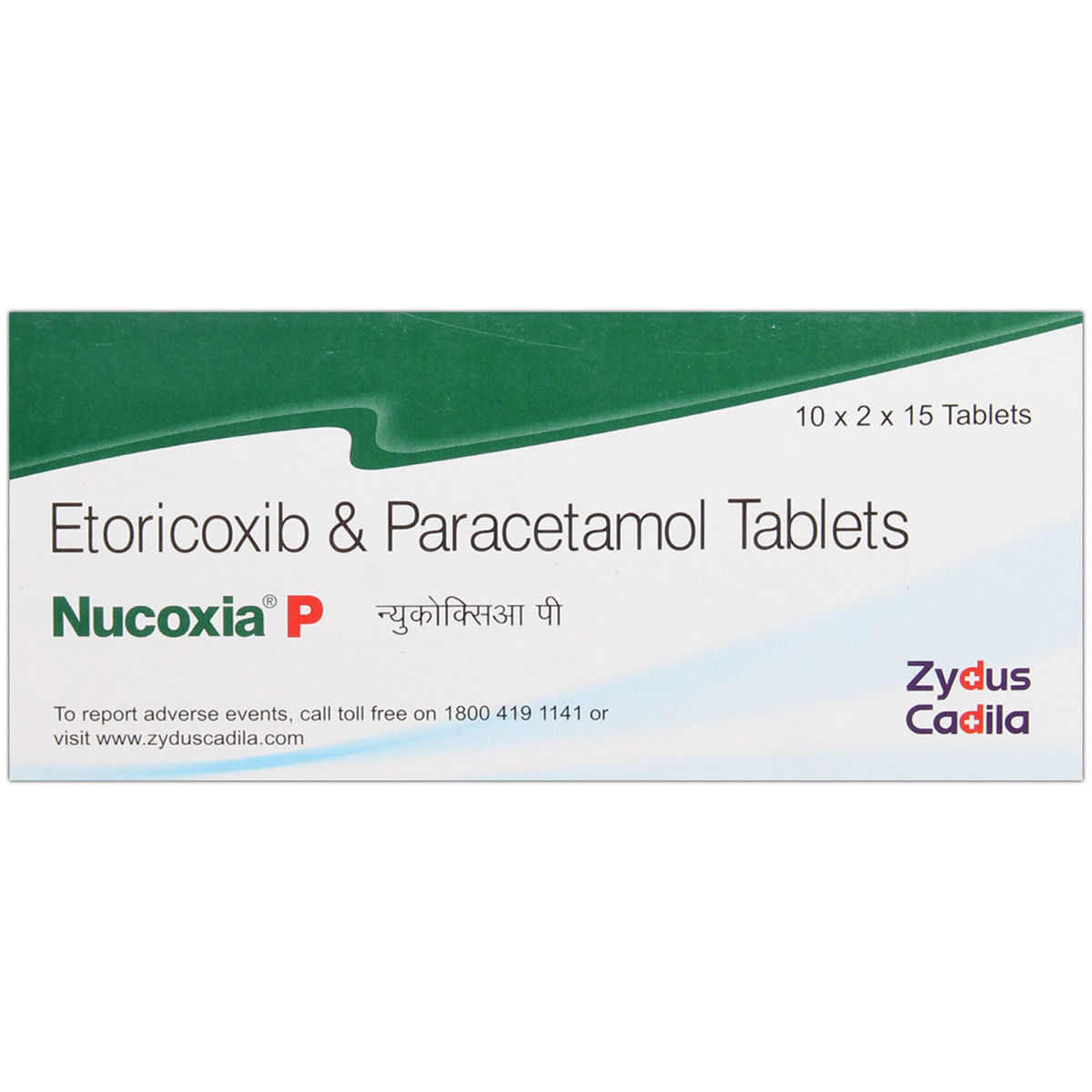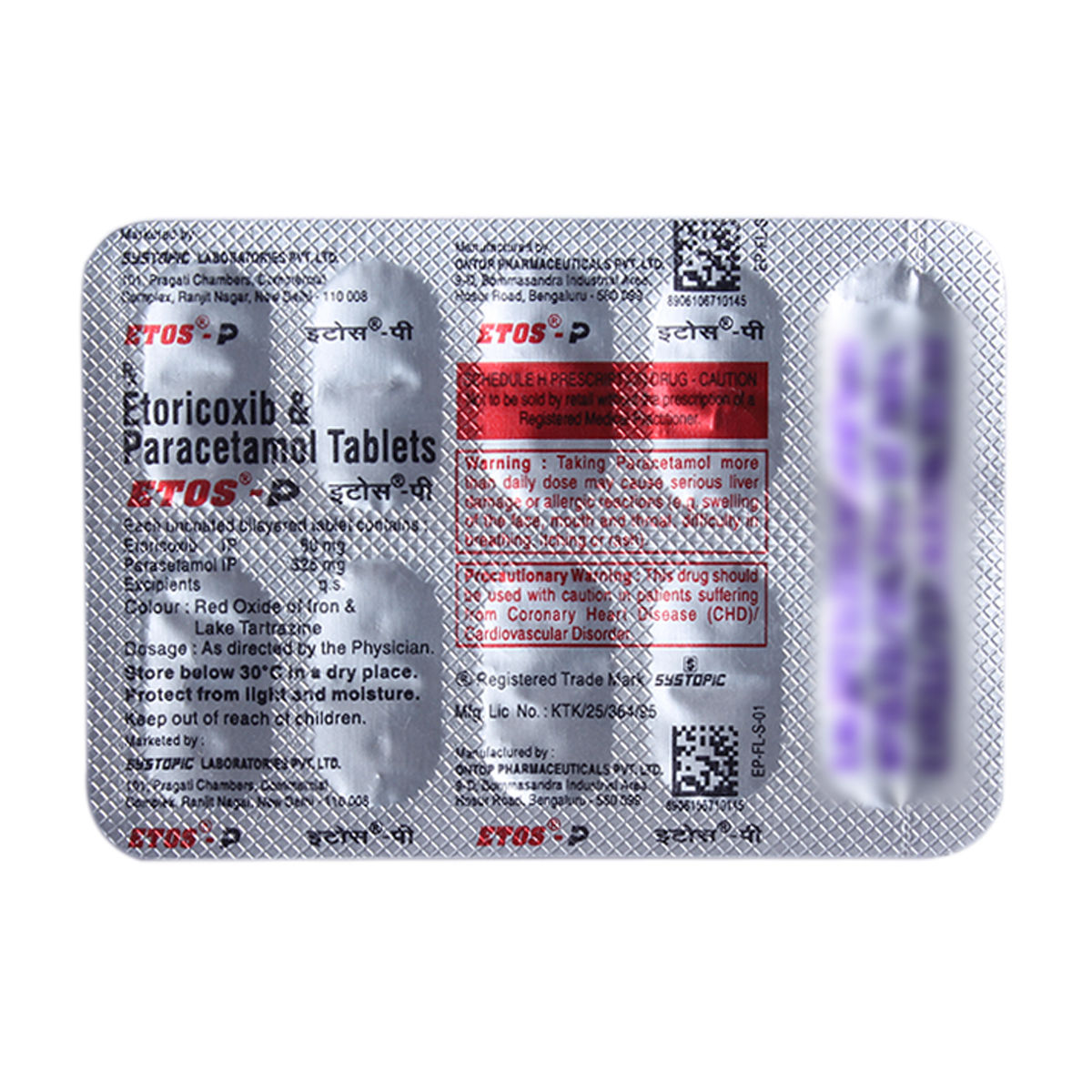Etoricoxib+paracetamol
About Etoricoxib+paracetamol
Etoricoxib+paracetamol belongs to a group of medicines called Non-Steroidal Anti-Inflammatory Drugs (NSAIDs) used to relieve pain and inflammation in the conditions such as osteoarthritis, rheumatoid arthritis, gouty arthritis, ankylosing spondylitis, tooth pain, headache, nerve pain, muscular pain, back pain, fever, cold, and flu. Pain is a symptom triggered by the nervous system, causing uncomfortable sensations in the body.
Etoricoxib+paracetamol is a combination of two drugs, namely: Etoricoxib and Paracetamol. Etoricoxib+paracetamol works by blocking the effect of a chemical messenger known as cyclo-oxygenase (COX) enzyme that makes another chemical, prostaglandin, which causes pain and inflammation. By blocking the effect of COX enzymes, fewer prostaglandins are produced. This helps in reducing mild to moderate pain and inflammation at the injured or damaged site.
You are advised to take Etoricoxib+paracetamol for as long as your doctor has prescribed it for you, depending on your medical condition. In some cases, you may experience certain common side effects, such as flatulence, constipation, nausea, diarrhoea, and swelling of hands and feet. Most of these side effects do not require medical attention and will resolve gradually over time. However, you are advised to talk to your doctor if you experience these side effects persistently.
Consult your doctor if you are pregnant or breastfeeding. Etoricoxib+paracetamol may cause sleepiness and dizziness, so drive with caution. Etoricoxib+paracetamol should not be given to children as safety and efficacy have not been established. Avoid consuming alcohol as it could lead to increased dizziness; it might also increase stomach bleeding risk. Keep your doctor informed about your health condition and medicines to rule out any side effects.
Uses of Etoricoxib+paracetamol
Medicinal Benefits
Etoricoxib+paracetamol is a combination of two Non-Steroidal Anti-Inflammatory Drugs (NSAIDs), namely: Etoricoxib and Paracetamol. Etoricoxib+paracetamol is used to relieve pain in osteoarthritis, rheumatoid arthritis, gouty arthritis and ankylosing spondylitis, tooth pain, headache, nerve pain, muscular pain, back pain, fever, cold, and flu. Etoricoxib+paracetamol works by blocking the effect of a chemical messenger known as cyclo-oxygenase (COX) enzyme that makes another chemical prostaglandin. These prostaglandins are produced at injury sites and cause pain and swelling. By blocking the effect of COX enzymes, fewer prostaglandins are produced. This helps in reducing mild to moderate pain and inflammation at the injured or damaged site.
Directions for Use
Storage
Side Effects of Etoricoxib+paracetamol
- Flatulence
- Constipation
- Nausea
- Diarrhoea
- Swelling of hands and feet (oedema)
- Skin rash
Drug Warnings
Do not take Etoricoxib+paracetamol if you are allergic to Etoricoxib+paracetamol or other NSAIDs. Inform your doctor if you have stomach ulcers, or have suffered bleeding problems, clotting problems, inflammatory bowel disease, heart failure, high blood pressure, diabetes, high cholesterol, severe heart, liver or kidney problems. If you have had any recent heart surgery, do not take Etoricoxib+paracetamol unless prescribed by the doctor, as Etoricoxib+paracetamol may increase the risk of heart attack or stroke. Consult your doctor if you are pregnant or breastfeeding. Etoricoxib+paracetamol may cause sleepiness and dizziness, so drive only if you are alert. Etoricoxib+paracetamol should not be given to children as safety has not been established. Avoid consuming alcohol along with Etoricoxib+paracetamol as it could lead to increased drowsiness and can increase the risk of stomach bleeding. Stop taking Etoricoxib+paracetamol and consult your doctor immediately if you have stomach pain or any signs of bleeding in the intestine or stomach, such as blood in stools. Do not take any other NSAIDs for pain relief along with Etoricoxib+paracetamol unless prescribed.
Drug Interactions
Drug-Drug Interactions: Etoricoxib+paracetamol may interact with pain killers (aspirin), bronchodilators (salbutamol), anti-depressants (lithium), cardiac glycoside (digoxin), anti-hypertensives (enalapril, ramipril, losartan, valsartan, minoxidil), antibiotics (rifampicin), antacid (ranitidine), blood thinners (warfarin), immunosuppressants (cyclosporine, tacrolimus), anti-emetic (metoclopramide, domperidone), bile-acid sequestrant (cholestyramine).
Drug-Food Interactions: Avoid alcohol consumption while taking Etoricoxib+paracetamol as it might cause increased dizziness and risk of stomach bleeding.
Drug-Disease Interactions: Inform your doctor if you have stomach ulcers, blood disorders, stomach disorders, diabetes, high blood pressure, high cholesterol, heart, kidney or liver problems.
Drug-Drug Interactions Checker List:
Safety Advice

Alcohol
unsafeAvoid consumption of alcohol while taking Etoricoxib+paracetamol as it may cause increased drowsiness. It can also increase the risk of stomach bleeding.

Pregnancy
cautionPlease consult your doctor if you have any concerns regarding this; your doctor will prescribe only if the benefits outweigh the risks.

Breast Feeding
cautionPlease consult your doctor before taking Etoricoxib+paracetamol; your doctor will decide whether Etoricoxib+paracetamol can be taken by breastfeeding mothers or not.

Driving
cautionEtoricoxib+paracetamol may cause dizziness and sleepiness. Do not drive or operate machinery unless you are alert.

Liver
cautionDose adjustment may be needed in patients with liver impairment. Please consult your doctor if you have a liver impairment or any concerns regarding this.

Kidney
cautionDose adjustment may be needed in patients with kidney impairment. Please consult your doctor if you have kidney impairment or any concerns regarding this.

Children
unsafeEtoricoxib+paracetamol should not be given to children as the safety and effectiveness were not established.
Habit Forming
Diet & Lifestyle Advise
- Physical activity helps in strengthening muscles and relieves joint stiffness. Gentle activities like 20-30minutes of walking or swimming would be helpful.
- Performing yoga may also help in improving joint flexibility and pain management.
- Maintain a healthy weight by performing regular low-strain exercises and eating healthy food.
- Get adequate sleep, as resting the muscles can help in reducing inflammation and swelling.
- Follow heat or cold therapy; apply a cold or hot compress on the joints for 15-20minutes regularly.
- De-stress yourself by meditating, reading books, taking a warm bubble bath or listening to soothing music.
- Acupuncture, massage and physical therapy may also be helpful.
- Eat food rich in antioxidants such as berries, spinach, kidney beans, dark chocolate, etc.
- Foods containing flavonoids help in reducing inflammation. These include soy, berries, broccoli, grapes and green tea.
- Avoid smoking and alcohol consumption.
Special Advise
- Etoricoxib+paracetamol might cause changes in blood tests. Inform the person doing the tests that you are taking Etoricoxib+paracetamol.
Patients Concern
Disease/Condition Glossary
Pain: Pain is a symptom triggered by the nervous system, causing uncomfortable sensations in the body. Pain may be dull or sharp; it might be constant or may come and go. The tolerance level of pain might vary from person to person. Pain can be generalized (overall body aches) or localized (affecting a specific area of the body). The common causes of pain include headache, muscle strain, cramps, cuts, bone fractures, and arthritis.
Osteoarthritis: It is a degenerative joint disease in which the two ends of the joints come together due to the breakdown of a protective covering of cartilage. Due to the absence of this protective covering, the joints rub against each other, leading to pain and stiffness. Symptoms of osteoarthritis include pain, stiffness, inflammation and tenderness.
Rheumatoid arthritis: It is an auto-immune disease (the body's immune system attacks its tissue), leading to joint pain and damage. Symptoms of rheumatoid arthritis include pain, swelling, stiffness, deformities and loss of joint function.
Gouty arthritis: It is caused due to deposits of excess uric acid crystals in the joints, which leads to pain and inflammation in the joints. Symptoms include pain, swelling, and redness in the joints, mostly the big toe.
FAQs
Etoricoxib+paracetamol is used to relieve pain and inflammation in conditions such as osteoarthritis, rheumatoid arthritis, gouty arthritis, ankylosing spondylitis, tooth pain, headache, nerve pain, muscular pain, back pain, fever, cold, and flu.
Etoricoxib+paracetamol works by blocking the effect of chemical messengers that cause pain and inflammation.
Etoricoxib+paracetamol is used to reduce and relieve pain and inflammation associated with osteoarthritis, rheumatoid arthritis, gouty arthritis and ankylosing spondylitis. Arthritis is the tenderness and swelling of the joints.
Avoid taking Etoricoxib+paracetamol if you have stomach ulcers, bleeding problems, or heart problems. Talk to your doctor regarding your concerns; he/she may prescribe alternate medicine.
Diarrhoea might be a side-effect of Etoricoxib+paracetamol. Drink enough fluids and eat non-spicy food if you experience diarrhoea. If you find blood in stools (tarry stools) or if you experience severe diarrhoea, consult your doctor. Do not take anti-diarrheal medicine on your own.
Etoricoxib+paracetamol might cause swelling of feet and hands due to fluid retention (oedema). While lying down, raise your legs above by putting a pillow below them. Follow a low-salt diet as it might help in reducing fluid build-up.
Etoricoxib+paracetamol along with birth control pills might increase the risk of side effects. Please consult your doctor, he/she may suggest an alternate method of contraception.
Yes, the use of Etoricoxib+paracetamol causes dizziness. If you feel dizzy, take rest for some time and resume when you feel better. However, consult the doctor if the dizziness persists for longer time or worsens.
Yes, the use of Etoricoxib+paracetamol is contraindicated in patients with known allergic reactions to NSAIDs. If you have heart disease, gastrointestinal ulcers, kidney or liver impairment, high blood pressure, and asthma. Please, consult a doctor before taking Etoricoxib+paracetamol.
Yes, the long-term use of Etoricoxib+paracetamol can cause damage to the kidneys. Normal kidneys produce prostaglandins, a chemical that protects them from damage. Long term use of painkillers lowers the prostaglandins levels in the body leading to kidney damage. Therefore, inform your doctor if you have any kidney problem before taking Etoricoxib+paracetamol.
No, taking Etoricoxib+paracetamol in higher doses than recommended is not effective. It leads to an increase of unwanted side effects. If your symptoms are worsening, please consult your doctor.
Etoricoxib+paracetamol contains Paracetamol which is known to cause liver damage especially if taken in higher than recommended doses. Also, avoid alcohol consumption with Etoricoxib+paracetamol as it increases the risk of liver damage. If you notice any of the early signs and symptoms such as dark urine, yellow skin or eyes, fever, loss of appetite, please consult the doctor immediately.
Store Etoricoxib+paracetamol at room temperature in a cool and dry place. Keep it out of reach of children and pets. Disposal of Etoricoxib+paracetamol is done by following the local guidelines.
Etoricoxib+paracetamol should be continued for as long as advised by your doctor, when used for long-term pain relief. It can be discontinued if you are using it for short-term pain relief.
Etoricoxib+paracetamol causes side effects such as constipation, nausea, skin rash, swelling of hands and feet, diarrhoea, headache, increased blood pressure, ingestion, and stomach pain. Please, consult the doctor if these side effects persists or worsens.






